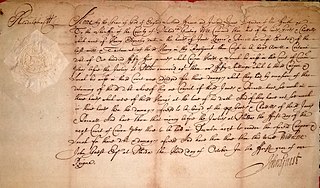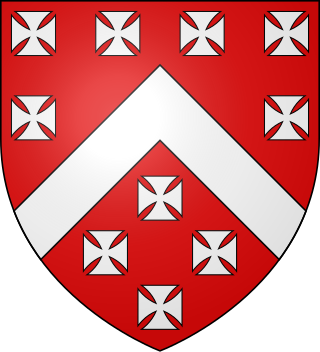Related Research Articles

In common law, a writ is a formal written order issued by a body with administrative or judicial jurisdiction; in modern usage, this body is generally a court. Warrants, prerogative writs, subpoenas, and certiorari are common types of writs, but many forms exist and have existed.

Baron de Ros of Helmsley is the premier baron in the Peerage of England, created in 1288/89 for William de Ros, with precedence to 24 December 1264. Premier baron is a designation and status awarded to the holder of the most ancient extant barony of the Peerage of England. Before the Dissolution of the Monasteries the Prior of the Order of St John in England was deemed the premier baron.

Baron Wharton is a title in the Peerage of England, originally granted by letters patent to the heirs male of the 1st Baron, which was forfeited in 1729 when the last male-line heir was declared an outlaw. The Barony was erroneously revived in 1916 by writ of summons, thanks to an 1844 decision in the House of Lords based on absence of documentation. As such, the current Barony of Wharton could more accurately be listed as a new Barony, created in 1916, with the precedence of the older Barony.

The title Baron Berkeley originated as a feudal title and was subsequently created twice in the Peerage of England by writ. It was first granted by writ to Thomas de Berkeley, 1st Baron Berkeley (1245–1321), 6th feudal Baron Berkeley, in 1295, but the title of that creation became extinct at the death of his great-great-grandson, the fifth Baron by writ, when no male heirs to the barony by writ remained, although the feudal barony continued. The next creation by writ was in 1421, for the last baron's nephew and heir James Berkeley. His son and successor William was created Viscount Berkeley in 1481, Earl of Nottingham in 1483, and Marquess of Berkeley in 1488. He had no surviving male issue, so the Marquessate and his other non-inherited titles became extinct on his death in 1491, whilst the barony passed de jure to his younger brother Maurice. However, William had disinherited Maurice because he considered him to have brought shame on the noble House of Berkeley by marrying beneath his status to Isabel, daughter of Philip Mead of Wraxhall, an Alderman and Mayor of Bristol. Instead, he bequeathed the castle, lands and lordships comprising the Barony of Berkeley to King Henry VII and his heirs male, failing which to descend to William's own rightful heirs. Thus on the death of King Edward VI in 1553, Henry VII's unmarried grandson, the Berkeley inheritance returned to the family. Therefore, Maurice and his descendants from 1492 to 1553 were de jure barons only, until the return of the title to the senior heir Henry, becoming de facto 7th Baron in 1553. Upon his death he was succeeded by his relative George Harding.

A lithopedion, or stone baby, is a rare phenomenon which occurs most commonly when a fetus dies during an abdominal pregnancy, is too large to be reabsorbed by the body, and calcifies on the outside as part of a foreign body reaction, shielding the mother's body from the dead tissue of the fetus and preventing infection.
A shotgun wedding is a wedding arranged in response to pregnancy resulting from premarital sex. The phrase is a primarily U.S. colloquialism, termed as such based on a stereotypical scenario in which the father of the pregnant bride-to-be threatens the reluctant groom with a shotgun in order to ensure that he follows through with the wedding.
The hereditary peers form part of the peerage in the United Kingdom. As of August 2023, there are 805 hereditary peers: 30 dukes, 34 marquesses, 189 earls, 110 viscounts, and 442 barons.

Pregnancy is the time during which one or more offspring develops (gestates) inside a woman's uterus (womb). A multiple pregnancy involves more than one offspring, such as with twins.
The paternal rights and abortion issue is an extension of both the abortion debate and the fathers' rights movement. Abortion can be a factor for disagreement and lawsuit between partners.
The title Baron Latimer or Latymer has been created, by the definitions of modern peerage law, four times in the Peerage of England. Of these, one was restored from abeyance in 1913; one is forfeit; the other two are dormant, although their heir is well known.
A writ in acceleration, commonly called a writ of acceleration, is a type of writ of summons that enabled the eldest son and heir apparent of a peer with more than one peerage to attend the British or Irish House of Lords, using one of his father's subsidiary titles, during his father's lifetime. This procedure could be used to bring younger men into the Lords and increase the number of capable members in a house that drew on a very small pool of talent.

Maria Luisa of Parma was, by marriage to King Charles IV of Spain, Queen of Spain from 1788 to 1808 leading up to the Peninsular War. Her relationship with Manuel Godoy and influence over the King made her unpopular among the people and aristocrats. She was rivals with the Duchess of Alba and the Duchess of Osuna. The death of her daughter-in-law Princess Maria Antonia of Naples and Sicily, whom she disliked, was said to be the poisoning by the Queen.
The jury of matrons was a form of special jury at English common law, usually used to resolve legal disputes over whether or not a party to a legal action was pregnant.
Nasciturus pro iam nato habetur, quotiens de commodis eius agitur is a Latin legal maxim that refers to a law that grants or protects the right of a fetus to inherit property. The maxim translates, "The unborn is deemed to have been born to the extent that his own benefits are concerned". "Nasciturus" literally translates to "one who is to be born" and refers to a conceived foetus: a living child who has not yet been born. Pursuant to the legal principle, the fetus is presumed to have been born for the purposes of inheritance. The principle was reified in Roman law and continues to be implemented today in most European nations, in the Americas, and in South Africa.
The sleeping child, according to Moroccan and the wider Maghrebian folk belief, is a fetus which has been rendered dormant by black or white magic and may eventually wake up and be born after the normal pregnancy term. This belief, supported by the concept that God's will controls everything and that no event should be considered truly impossible, is used by local communities to deal with occasional cases of pregnancy in women with absentee husbands, a frequent situation in the modern era due to the large number of males working as immigrant labor in Europe. This folk belief is used to dismiss an accusation of adultery and the consequences that such an accusation would bring.
In law, venire facias, also venire facias juratores, and often shortened to venire, is a writ directing a sheriff to assemble a jury. Various types are:
In English law, the assize of mort d'ancestor was an action brought where a plaintiff claimed the defendant had entered upon a freehold belonging to the plaintiff following the death of one of his relatives. The questions submitted to the jury were, "was A seised in his demesne as of fee on the day whereon he died?" and "Is the plaintiff his next heir?" This assize enabled the heir to obtain possession, even though some other person might have a better right to the land than the deceased.

In the kingdom of England, a feudal barony or barony by tenure was the highest degree of feudal land tenure, namely per baroniam, under which the land-holder owed the service of being one of the king's barons. The duties owed by and the privileges granted to feudal barons are not exactly defined, but they involved the duty of providing soldiers to the royal feudal army on demand by the king, and the privilege of attendance at the king's feudal court, the precursor of parliament.
An Inquisition post mortem is an English medieval or early modern record of the death, estate and heir of one of the king's tenants-in-chief, made for royal fiscal purposes. The process of making such inquisition was effected by the royal escheators in each county where the deceased held land. The earliest inq.p.m. was made in 1236, in the reign of King Henry III (1216–1272), and the practice ceased c. 1640, at the start of the English Civil War, and was finally abolished by the Tenures Abolition Act 1660, which ended the feudal system.